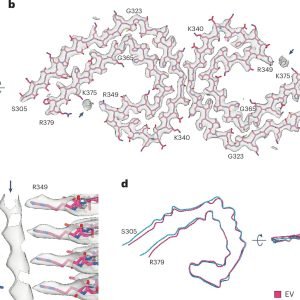
Medical imaging is no longer in Kansas, Toto, as a team led by Penn State researchers brings traditional black and white diagnostic images of X-rays and traditional CT scans into technicolor. The researchers developed novel contrast agents that target two proteins implicated in osteoarthritis, a degenerative joint disease commonly characterized as wear-and-tear arthritis.
By marking the proteins with the contrast agents comprising newly designed metal nanoprobes, the researchers can use advanced imaging called “K-edge” imaging or photon-counting computed tomography (CT) to simultaneously track separate biological processes in color that, together, reveal more about the disease’s progression than a traditional scan.
The team published its findings in Advanced Science. The work—done in rats but with implications for humans—allows researchers and clinicians to see previously obscured processes in color and observe evidence of the disease long before clinical symptoms develop.
“If we can develop a contrast agent—a metal nanoprobe—tailored to identify and quantify target particles, there is very little we cannot see with the photon-counting CT scanner,” said first author Nivetha Gunaseelan, doctoral student in biomedical engineering at Penn State.
“And that visualization is especially important when it comes to diseases such as osteoarthritis, which can progress unnoticed until clinical presentation, which is often at an advanced and irreversible stage.
“Early intervention could reduce symptoms and improve lifestyle, if we have the tools to enable early diagnosis and longitudinal disease tracking. We can enhance imaging techniques to detect early cartilage changes at a molecular level, and that could help improve diagnosis and monitoring.”
The work hinges on a relatively new technology, the photon-counting computed tomography (CT) scanner, that reveals the same bone, muscle and fat that conventional CT scanners can detail, but has a far wider ability to separate various components at a higher resolution and in designated colors.
A version of this advanced scanner, produced by Siemens, was approved by the U.S. Food and Drug Administration for clinical use and is now being placed at some hospitals, but its smaller scale, molecular imaging capabilities for clinical applications have remained largely unexplored, according to the researchers.
The photon-counting CT scanner tracks materials with unique K-edge identities, which refers to how electrons in a material absorb energy. Electrons sit on a K-shell, a kind of casing that encompasses the nucleus of an atom. As energy is absorbed from photons, or particles of light, the electrons can jump to more external shells. The atom can absorb a certain amount of energy, and when that limit is hit, the atom will emit a flash of light.
The researchers can tell the scanner to track that particular light emission, called the K-edge. If a material with a distinctive K-edge identity also targets a specific protein, the researchers can use the scanner to track that protein’s activity.
“This high-resolution, K-edge-based imaging approach could potentially be used to image multiple biological targets, thus enabling disease progression tracking over time by measuring the ratio of protein expression,” said corresponding author Dipanjan Pan, the Dorothy Foehr Huck & J. Lloyd Huck Chair Professor in Nanomedicine and professor of materials science and engineering and of nuclear engineering at Penn State.
“The approach can be particularly beneficial in skeletal disease diagnoses since the progression of cartilage degradation is highly variable among patients and the ratio information from the protein markers could provide crucial information about the stage of the disease.”
The researchers designed two K-edge metal nanoprobes, made of praseodymium and hafnium. The probes target two proteins in cartilage tissue: aggrecan and aggrecanase, respectively. Aggrecan, which helps provide structure and the ability to bear weight to cartilage, is abundant in healthy joints and in early stages of osteoarthritis.
Aggrecanase, which cleaves aggrecan and limits cartilage’s abilities, is abundant in the late stages of osteoarthritis. As the disease progresses, the ratio of the proteins shift, providing metrics to track disease status.
The team used the photon-counting CT scanner to track how the ratio shifted as the disease progressed in an animal model. They used additional imaging and experimental validation to corroborate their results.
“X-ray imaging has advanced greatly since Röntgen’s first demonstration,” Pan said, referring to Wilhelm Röntgen, the physicist who produced the first radiograph in 1895, with the hand of Anna Bertha, his wife, as the subject.
“This technique has the advantage of capturing images quickly, making it a good choice for emergency situations, but it lacks soft tissue contrast and cannot separate the imaging signal from the disease site from that of intrinsic structures, such as bones.”
However, Pan explained, advanced detector technologies like photon-counting CT scanning and K-edge imaging—which his lab has worked on for more than a decade—have enabled highly precise and detailed imaging.
“We are now able to count individual photons, and as a result, we can generate ‘hot spot’-like images based on an element’s K-edge energy,” Pan said. “The results of our experiment demonstrate—for the first time—that a complementary biological process can be followed in multicolor, with a clinically relevant modality.”
Photon-counting CT scanning offers several clinical applications derived from such advantages as immunity to electronic noise and high-resolution imaging without compromising quantum efficiency, according to Pan.
“We showed the potential of K-edge nanoprobes and photon-counting CT scanning in detecting critical stages of osteoarthritis before symptom development and clinical presentation with advanced stages,” Pan said. “It is anticipated that the synergistic development of these tools will determine the success of this field.”
More information:
Nivetha Gunaseelan et al, Targeted K‐Edge Nanoprobes From Praseodymium and Hafnium for Ratiometric Tracking of Dual Biomarkers using Spectral Photon Counting CT, Advanced Science (2024). DOI: 10.1002/advs.202408408
Citation:
New technique allows technicolor imaging of degenerative joint disease (2024, October 28)
retrieved 28 October 2024
from https://medicalxpress.com/news/2024-10-technique-technicolor-imaging-degenerative-joint.html
This document is subject to copyright. Apart from any fair dealing for the purpose of private study or research, no
part may be reproduced without the written permission. The content is provided for information purposes only.







